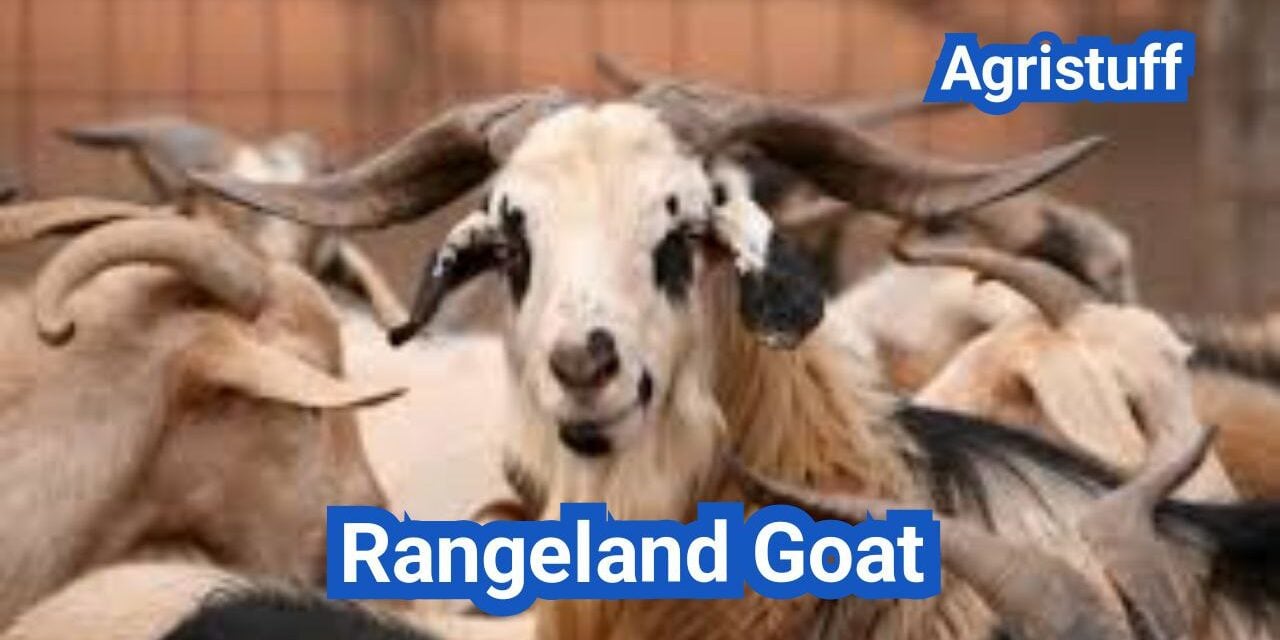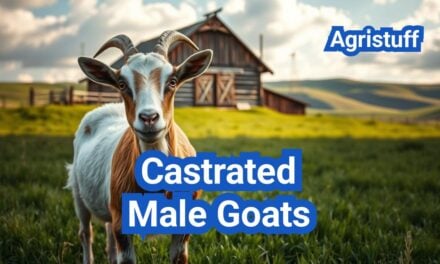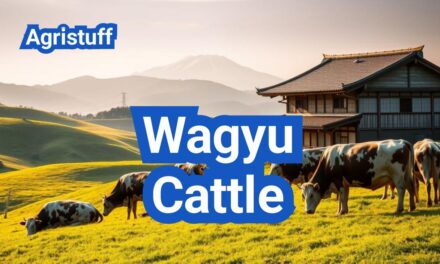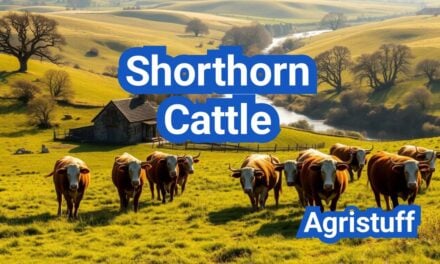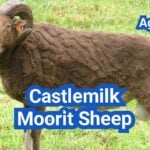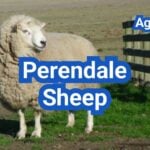The Rangeland Goat is an Australian breed renowned for its hardiness and versatility in meat production. Originating in Australia, this breed has been developed to thrive in various environments.
Known for its robust characteristics, the Rangeland Goat is a significant breed in the livestock industry. Its history, breeding practices, and uses are essential aspects that define its importance.
This introduction provides an overview of the Rangeland Goat, covering its history, origin, characteristics, breeding practices, and uses, setting the stage for a detailed exploration in subsequent sections.
Key Takeaways
- Understanding the Rangeland Goat’s history and origin
- Characteristics that define the Rangeland Goat breed
- Breeding practices for Rangeland Goats
- Uses of Rangeland Goats in the livestock industry
- Significance of Rangeland Goats in meat production
The Origin and History of Rangeland Goats
The Rangeland Goat, a breed known for its hardiness and versatility, has a rich history that traces back to its development in Australia. This breed was developed from various goat breeds introduced to Australia, which over time adapted to the country’s diverse climates and terrains.
Early Development in Australia
The early development of Rangeland Goats in Australia was influenced by the introduction of goats by European settlers. These goats were initially used for meat and milk production. Over time, they adapted to the Australian environment, developing characteristics that would define the Rangeland Goat breed.
The adaptation process was largely driven by natural selection, as the goats that were better suited to the local conditions were more likely to survive and reproduce. This selective pressure led to the development of a robust and resilient breed.
“The Rangeland Goat’s ability to thrive in challenging environments is a testament to its hardiness and adaptability.”
— Australian Goat Breeders Association
Evolution into a Distinct Breed
As the Rangeland Goat breed continued to evolve, it became distinct from other goat breeds due to its unique characteristics and traits. The breed’s evolution was influenced by factors such as climate, terrain, and farming practices.
| Characteristic | Description |
|---|---|
| Hardiness | Ability to withstand harsh climatic conditions |
| Versatility | Adaptability to various farming systems |
| Meat Production | High-quality meat suitable for various markets |
The Rangeland Goat’s evolution into a distinct breed has made it a valuable asset for farmers in Australia and beyond. Its hardiness, versatility, and meat production capabilities make it an attractive option for a wide range of farming operations.
What Is a Rangeland Goat?

The Rangeland Goat is a breed that has gained recognition for its hardiness and meat production capabilities. This breed is known for its ability to thrive in challenging environments, making it a valuable asset for farmers worldwide.
Definition and Classification
Rangeland Goats are classified as a distinct breed due to their unique characteristics and adaptability. They are primarily used for meat production and are known for their robust health and resilience.
The classification of Rangeland Goats involves understanding their origins, physical traits, and breeding history. They are often categorized alongside other meat goat breeds, but their specific characteristics set them apart.
Comparison with Other Meat Goat Breeds
When comparing Rangeland Goats to other meat goat breeds, several key differences emerge. The following table highlights some of the main distinctions:
| Breed Characteristics | Rangeland Goat | Boer Goat | Kiko Goat |
|---|---|---|---|
| Origin | Australia | South Africa | New Zealand |
| Primary Use | Meat Production | Meat Production | Meat Production |
| Hardiness | High | High | High |
| Growth Rate | Moderate | Fast | Moderate |
Rangeland Goats are often compared to Boer Goats, another popular meat goat breed. While both breeds are hardy and used for meat production, Rangeland Goats are known for their adaptability to dry climates and robust health. Boer Goats, on the other hand, are recognized for their fast growth rate and larger size.
In comparison to other breeds like the Kiko Goat, Rangeland Goats share similarities in hardiness but may differ in growth rates and specific physical characteristics.
Physical Characteristics of Rangeland Goats
Rangeland Goats are characterized by their varied size and coat colors, making them a unique breed. Their physical attributes are a testament to their adaptability and resilience in various environments.
The physical characteristics of Rangeland Goats can be broken down into several key areas: size and weight, coat and color variations, and distinctive physical traits.
Size and Weight Specifications
Rangeland Goats vary significantly in size and weight, largely due to their genetic diversity and the environments in which they are raised.
- Adult Rangeland Goats typically weigh between 30 kg to 50 kg (66 lbs to 110 lbs).
- Their height at the shoulder can range from 0.6 meters to 0.8 meters (24 inches to 32 inches).
These specifications make them suitable for various farming conditions.
Coat and Color Variations
One of the notable features of Rangeland Goats is their coat and color variations.
- Their coats can be short, medium, or long, depending on the climate and genetics.
- Colors range from white, red, black, and various patterns such as spotted or brindle.
The diversity in their coat colors and patterns is a result of their mixed ancestry and adaptation to different environments.
Distinctive Physical Traits
Rangeland Goats have several distinctive physical traits that contribute to their hardiness and adaptability.
- Strong legs and hooves that are well-suited to rugged terrain.
- A robust body that can withstand harsh weather conditions.
- Ears that are generally medium in size and can be erect or slightly drooping.
These traits make Rangeland Goats an excellent choice for farming in challenging environments.
Behavioral Traits and Adaptability
Understanding the behavioral traits of Rangeland goats is crucial for effective management and utilization of their grazing habits. Rangeland goats are known for their hardiness and adaptability, traits that have been honed through their history and development in challenging environments.
Natural Behavior Patterns
Rangeland goats exhibit a range of natural behaviors that are essential to their survival and productivity. They are gregarious animals, often forming large herds in the wild. This social behavior is important for their protection and foraging efficiency. They have a hierarchical structure within their groups, with dominant animals leading the way to food and water sources.
Adaptability to Dry Climates
One of the key advantages of Rangeland goats is their adaptability to dry climates. They can survive and thrive in conditions where other breeds might struggle, making them ideal for regions with low rainfall. Their ability to withstand harsh weather conditions and poor forage quality is a testament to their hardiness.
Rangeland goats achieve this adaptability through several physiological and behavioral mechanisms. They are efficient browsers, capable of utilizing a wide range of vegetation types, including shrubs and trees that other livestock might avoid. This ability helps them survive in areas with limited grass cover.
Grazing Habits and Vegetation Management
The grazing habits of Rangeland goats play a significant role in vegetation management. They are known to be selective browsers, targeting specific plants and vegetation types. This selectivity can be advantageous in managing vegetation, as it allows for the control of unwanted plant species and the promotion of more desirable vegetation.
Effective grazing management with Rangeland goats requires an understanding of their grazing habits and how they interact with their environment. By leveraging their natural behaviors, farmers can implement sustainable grazing practices that enhance the overall health of their pastures.
How to Start Raising Rangeland Goats

Embarking on Rangeland Goat farming necessitates a thorough understanding of the basics. To successfully start raising Rangeland Goats, one must consider several key factors, including setting up the property, purchasing the right goats, and navigating the accreditation process.
Setting Up Your Property
The first step in Raising Rangeland Goats is to ensure your property is adequately prepared. This involves:
- Assessing the land for suitable grazing areas and shelter.
- Fencing the property to secure the goats and protect them from predators.
- Providing adequate water supply and nutritional feed.
Purchasing Your First Rangeland Goats
When it comes to purchasing your first Rangeland Goats, selecting healthy, robust animals is crucial. Consider the following:
- Source goats from reputable breeders to ensure quality.
- Inspect the goats for any signs of illness or weakness.
- Plan the purchase according to your farm’s capacity and resources.
Accreditation and Registration Process
Understanding the Rangeland Goat Accreditation process is vital for those serious about Rangeland Goat Farming. This involves:
- Registering your farm and goats with the relevant agricultural authorities.
- Meeting the specific criteria set for Rangeland Goat accreditation.
- Maintaining detailed records of your goats’ health, breeding, and sales.
By carefully setting up your property, purchasing quality goats, and following the accreditation process, you can establish a successful Rangeland Goat farm. This not only contributes to the sustainability of your farming practices but also enhances the profitability of your venture.
Essential Care and Management Practices
Proper care and management are vital for the overall health of Rangeland Goats. Effective Rangeland Goat management involves a combination of daily care, health monitoring, and seasonal adjustments to ensure their well-being and productivity.
Daily Care Requirements
Rangeland Goats need access to clean water, adequate nutrition, and suitable shelter. Ensuring that their dietary needs are met is crucial for their health and productivity. A balanced diet that includes a mix of grazing and supplementary feeding is essential, especially during periods of drought or when pasture quality is poor.
Daily checks should include monitoring for signs of illness, injury, or stress. Regular observation helps in early detection of health issues, allowing for timely intervention.
Health Monitoring and Common Issues
Health monitoring is a critical aspect of Rangeland Goat care. Regular checks for internal parasites, such as worms, and external parasites, like ticks and lice, are necessary. Vaccinations and dental care are also important components of a comprehensive health program.
| Health Issue | Symptoms | Management |
|---|---|---|
| Internal Parasites | Weight loss, diarrhea, anemia | Regular deworming, monitoring fecal egg counts |
| External Parasites | Itching, hair loss, skin irritation | Use of parasiticides, regular inspection |
Seasonal Management Considerations
Seasonal changes require adjustments in the care and management of Rangeland Goats. During hot summer months, ensuring adequate shade, water, and ventilation is crucial to prevent heat stress. In colder climates, providing shelter and adjusting nutrition to meet increased energy needs is vital.
Breeding and kidding seasons also require specific management practices. Planning for these periods involves preparing for increased nutritional needs of pregnant or lactating does and ensuring proper care for newborn kids.
Breeding Rangeland Goats Successfully

To breed Rangeland Goats successfully, farmers must consider several key factors, including the quality of breeding stock and kid management practices. A well-planned Rangeland Goat breeding program is crucial for the overall success of the farming operation.
Selecting Quality Breeding Stock
The selection of quality breeding stock is the foundation of a successful Rangeland Goat breeding program. Farmers should look for goats with desirable traits such as high fertility, good growth rates, and resistance to diseases.
When selecting breeding stock, it’s essential to consider the genetic diversity of the herd to avoid inbreeding and ensure the long-term health of the goats.
Breeding Seasons and Cycles
Understanding the breeding seasons and cycles of Rangeland Goats is vital for maximizing reproductive efficiency. Rangeland Goats are known to be seasonal breeders, with the breeding season typically occurring in the fall.
Farmers should plan the breeding season to coincide with the most favorable environmental conditions to ensure the highest conception rates and the birth of healthy kids.
Kid Management and Weaning
Kid management is a critical aspect of a Rangeland Goat breeding program. Proper care and nutrition during the early stages of life are essential for the health and development of the kids.
Weaning is another crucial step in kid management. It should be done at the appropriate age to minimize stress and ensure the kids continue to grow and thrive.
By focusing on these key areas, farmers can develop a successful Rangeland Goat breeding program that enhances the overall productivity and profitability of their farming operation.
Crossbreeding Strategies with Boer Goats

Crossbreeding Rangeland Goats with Boer Goats has emerged as a strategic approach to enhance meat production. This practice combines the hardiness of Rangeland Goats with the superior meat-producing qualities of Boer Goats.
Advantages of Crossbreeding
The crossbreeding of Rangeland Goats with Boer Goats offers several benefits. Increased growth rates and improved meat quality are among the primary advantages. This crossbreeding program can lead to a more robust and productive goat population.
The Rangeland-Boer cross is known for its hardiness and adaptability, making it suitable for various farming conditions. The offspring typically inherit the desirable traits from both parent breeds, resulting in a superior meat-producing animal.
Implementing a Crossbreeding Program
To implement a successful crossbreeding program, farmers should start by selecting high-quality breeding stock. This involves choosing Rangeland Goats with desirable traits and Boer Goats known for their meat-producing capabilities.
A well-planned breeding strategy is crucial. This includes deciding on the breeding season, managing the mating process, and ensuring proper care for the does and kids. Record-keeping is also essential to track the performance and lineage of the offspring.
Expected Outcomes
The expected outcomes of crossbreeding Rangeland Goats with Boer Goats include enhanced growth rates and improved meat production. The crossbred goats are likely to mature faster and produce higher-quality meat.
Farmers can anticipate a more profitable venture due to the increased efficiency and productivity of the crossbred goats. The adaptability of these goats to various environments also makes them a versatile choice for different farming systems.
Raising Rangeland Goats for Meat Production

Rangeland Goats are primarily raised for their meat, which is known for being lean and rich in flavor. The meat from these goats is considered a delicacy in many cultures, and its demand is on the rise due to its health benefits and unique taste.
Meat Quality and Characteristics
The meat of Rangeland Goats is characterized by its low fat content and high protein levels, making it a preferred choice for health-conscious consumers. The unique flavor profile is attributed to the goats’ diverse diet and the harsh conditions they are adapted to.
The quality of Rangeland Goat meat is also influenced by factors such as age, sex, and breeding practices. Generally, younger goats produce more tender meat, while older goats may have a more developed flavor.
Optimal Slaughter Age and Weight
Determining the optimal slaughter age and weight is crucial for maximizing the quality of Rangeland Goat meat. Typically, goats are slaughtered between 6 to 12 months of age, when they reach a weight of around 30 to 40 kilograms.
Slaughtering at the right age and weight ensures that the meat is tender and flavorful. Producers often aim for a balance between growth rate and meat quality to achieve the best market price.
Processing and Marketing Australian Rangeland Goat Meat
The processing of Rangeland Goat meat involves several steps, including slaughtering, dressing, and packaging. Australian producers adhere to strict quality control measures to ensure that the meat meets international standards.
Marketing strategies for Rangeland Goat meat often focus on its unique selling points, such as its lean profile and the sustainable practices used in its production. Producers may target niche markets that value these attributes, including high-end restaurants and health-oriented consumers.
By emphasizing the quality and characteristics of Rangeland Goat meat, producers can differentiate their products and achieve a competitive edge in the global market.
Economic Aspects of Rangeland Goat Farming

Understanding the economics of Rangeland Goat farming is essential for potential farmers. The economic viability of this type of farming depends on several key factors, including market prices, profit potential, and effective marketing strategies.
Current Market Prices and Trends
The current market prices for Rangeland Goats are influenced by various factors, including demand for goat meat, the overall health of the livestock market, and regional supply chains. As of the latest data, the prices for Rangeland Goats have shown a steady trend, with some fluctuations based on seasonal demand and supply.
Market Price Trends:
| Year | Average Price per Head | Trend |
|---|---|---|
| 2020 | $120 | Stable |
| 2021 | $125 | Slightly Increasing |
| 2022 | $130 | Increasing |
Calculating Profit Potential
To calculate the profit potential of Rangeland Goat farming, farmers must consider several expenses, including initial setup costs, ongoing care and management expenses, and the revenue generated from selling the goats or their products.
The profit potential can be maximized by:
- Optimizing breeding programs to increase kid production.
- Implementing effective grazing management to reduce feed costs.
- Exploring diverse marketing channels to reach higher-paying customers.
Effective Marketing Strategies
Effective marketing is crucial for the success of Rangeland Goat farming. Strategies include:
- Developing a strong online presence through websites and social media.
- Participating in agricultural fairs and livestock auctions.
- Building relationships with local butchers, restaurants, and specialty meat markets.
By understanding market trends, calculating profit potential accurately, and employing effective marketing strategies, Rangeland Goat farmers can enhance their economic viability and contribute to the sustainability of this farming practice.
Rangeland Goats in the United States

Rangeland Goats, originally from Australia, have been introduced to the U.S., where they are making a notable impact on local farming practices. Their hardiness and adaptability make them an attractive option for farmers looking to diversify their livestock.
Current Population and Distribution
The current population of Rangeland Goats in the United States is steadily growing, with a notable presence in regions that offer vast grazing lands. States like Texas, Arizona, and New Mexico have become hubs for Rangeland Goat farming due to their dry climates, which the goats are well-adapted to.
According to recent data, the distribution of Rangeland Goats is not limited to these states; they are also found in other parts of the country where the terrain and climate are suitable.
Adaptation to American Conditions
Rangeland Goats have shown a remarkable ability to adapt to the diverse climatic conditions found across the United States. Their ability to thrive in dry conditions makes them particularly well-suited to areas that experience drought or have limited water resources.
Key factors contributing to their adaptation include:
- Their robust physiology, which allows them to withstand harsh weather conditions.
- Their ability to graze on a wide variety of vegetation, making them versatile in different environments.
- Their resistance to certain diseases, which is beneficial in regions where disease prevalence is high.
Success Stories and Case Studies
Several farmers and ranchers in the United States have reported success with Rangeland Goat farming. One notable case study involves a ranch in Texas that transitioned to Rangeland Goat farming and saw a significant improvement in land management and profitability.
The benefits reported include:
- Improved land health due to the goats’ grazing habits, which help control vegetation.
- Increased profitability from the sale of goat meat and other products.
- Enhanced biodiversity as the goats contribute to a more balanced ecosystem.
These success stories highlight the potential of Rangeland Goat farming in the United States and demonstrate how this breed can contribute to sustainable agricultural practices.
Sustainable Farming with Rangeland Goats

Rangeland Goat farming offers a unique opportunity for sustainable land management and environmental stewardship. By integrating Rangeland Goats into farming systems, landowners can promote ecological balance and reduce the environmental footprint of their operations.
Environmental Benefits
Rangeland Goats contribute to sustainable farming through their grazing habits, which can help manage vegetation and reduce the risk of wildfires. Their ability to thrive in challenging environments means they can be used to maintain land health in areas where other livestock might struggle.
The environmental benefits of Rangeland Goat farming include improved land management and biodiversity conservation. By controlling invasive species and promoting the growth of native vegetation, Rangeland Goats play a crucial role in maintaining ecosystem health.
Sustainable Management Practices
To maximize the sustainability of Rangeland Goat farming, it’s essential to implement sustainable management practices. This includes rotational grazing to prevent overgrazing, regular health monitoring, and providing appropriate living conditions for the goats.
- Rotational grazing systems help maintain soil health and promote vegetation recovery.
- Regular monitoring of goat health reduces the need for antibiotics and other medications.
- Providing suitable shelter and living conditions enhances the overall welfare of the goats.
Integration with Other Farming Activities
Rangeland Goat farming can be effectively integrated with other farming activities to create a diverse and resilient agricultural system. For example, combining goat farming with crop production can help improve soil fertility and structure through the use of goat manure as fertilizer.
By adopting a mixed farming approach that includes Rangeland Goats, farmers can enhance biodiversity and improve the overall sustainability of their operations. This integrated approach can also help mitigate risks associated with market fluctuations and environmental challenges.
Common Challenges and How to Overcome Them

Rangeland Goat farmers encounter numerous challenges that can impact their farming success. These challenges can range from health issues in the goats to external factors like predators and market dynamics.
Disease Prevention and Treatment
Disease prevention is a critical aspect of Rangeland Goat farming. Implementing a robust health program can significantly reduce the risk of disease. Vaccination and parasite control are essential components of this program.
A study on disease management in Rangeland Goats highlighted the importance of regular health checks and maintaining a clean environment. “Regular monitoring and prompt treatment are key to preventing the spread of disease,” as noted by agricultural experts.
| Disease | Symptoms | Treatment |
|---|---|---|
| Parasites | Weight loss, diarrhea | Deworming medication |
| Pneumonia | Coughing, lethargy | Antibiotics |
Predator Management Strategies
Predator management is another significant challenge faced by Rangeland Goat farmers. Effective strategies include using guard animals like donkeys or dogs, and implementing fencing to protect the goats.
“Using guard animals has been a game-changer for our farm. It has significantly reduced losses to predators,” said a Rangeland Goat farmer.
Navigating Market Fluctuations
Market fluctuations can impact the profitability of Rangeland Goat farming. Farmers can navigate these fluctuations by diversifying their products and exploring new markets.
For instance, selling goat meat directly to consumers or restaurants can provide a more stable income stream compared to relying solely on wholesale markets.
- Identify new market opportunities
- Diversify products and services
- Build strong relationships with buyers
The Future of Rangeland Goat Farming
The future of Rangeland Goat farming appears promising, driven by the growing demand for goat meat and the increasing adoption of sustainable farming practices. As the Rangeland Goat industry continues to evolve, it is likely to be shaped by emerging trends and technologies that enhance productivity and efficiency.
One of the key factors influencing the Rangeland Goat Farming Future is the rising popularity of goat meat, driven by its nutritional benefits and culinary versatility. This trend is expected to continue, with the global goat meat market projected to grow in the coming years.
The Benefits of Rangeland Goats, including their hardiness, adaptability, and low maintenance requirements, make them an attractive option for farmers seeking to diversify their operations. As the Rangeland Goat Industry Trends continue to unfold, it is likely that we will see increased adoption of crossbreeding strategies, such as those involving Boer goats, to improve meat production and quality.
Overall, the outlook for Rangeland Goat farming is positive, with opportunities for farmers to capitalize on emerging trends and market demands. By understanding the Rangeland Goat Industry Trends and leveraging the Benefits of Rangeland Goats, farmers can position themselves for success in this growing industry.
FAQ
What is a Rangeland Goat?
A Rangeland Goat is a breed of goat that originated in Australia, known for its hardiness and adaptability to dry climates. They are often used for meat production and vegetation management.
What are the characteristics of Rangeland Goats?
Rangeland Goats are known for their robust size, varied coat colors, and ability to thrive in challenging environments. They are also recognized for their high reproductive rate and resistance to certain diseases.
How do Rangeland Goats differ from Boer Goats?
While both are used for meat production, Rangeland Goats are generally hardier and more adapted to harsh, dry conditions than Boer Goats. Boer Goats are specifically bred for their meat production characteristics, whereas Rangeland Goats are more of a general-purpose breed.
What do Rangeland Goats eat?
Rangeland Goats are browsers and will eat a wide variety of vegetation, including shrubs, trees, and grasses. Their diet can vary significantly depending on their environment.
Are Rangeland Goats easy to care for?
Rangeland Goats are considered relatively low maintenance compared to some other livestock. They are hardy and can thrive in challenging conditions with minimal care. However, they still require regular health checks, adequate fencing, and proper nutrition.
How long do Rangeland Goats live?
The lifespan of a Rangeland Goat can vary, but on average, they live between 10 to 15 years, depending on factors such as health, nutrition, and living conditions.
How much do Rangeland Goats cost?
The cost of Rangeland Goats can vary widely based on factors such as age, sex, quality, and location. Prices can range from a few hundred to several thousand dollars for high-quality breeding stock.
Can Rangeland Goats be raised for milk production?
While Rangeland Goats can produce milk, they are not typically raised for dairy purposes. Their milk production is generally lower than that of specialized dairy goat breeds.
What are the benefits of raising Rangeland Goats?
Raising Rangeland Goats offers several benefits, including their ability to thrive in challenging environments, their potential for meat production, and their role in vegetation management. They are also relatively inexpensive to start with and have a high reproduction rate.
What are some challenges of raising Rangeland Goats?
Challenges include managing their tendency to damage fences, preventing overgrazing, and dealing with predators. Regular veterinary care and proper fencing are essential to mitigate these issues.
How are Rangeland Goats used for vegetation management?
Rangeland Goats are used for vegetation management due to their browsing habits, which can help control unwanted vegetation, reduce fire risk, and promote a more diverse ecosystem.
Can Rangeland Goats be crossbred with other breeds?
Yes, Rangeland Goats can be crossbred with other breeds, such as Boer Goats, to improve meat production characteristics or enhance hardiness. Crossbreeding can result in offspring with desirable traits from both parent breeds.
Conclusion of: Rangeland Goat breed
Introduction to Rangeland Goat
The Rangeland Goat is a hardy Australian meat goat that has attracted growing interest from producers around the world who want efficient, low-maintenance animals for challenging environments. Originating in the vast semi-arid and arid regions of Australia, the Rangeland Goat has been shaped more by natural selection than by intensive human breeding, which makes the Rangeland Goat tough, fertile and adaptable.
For U.S. farmers and ranchers looking for goats that can thrive on brush, weeds and sparse forage while still producing a saleable carcass, the Rangeland Goat offers a very attractive option. Understanding the history, characteristics, management and uses of the Rangeland Goat will help you decide whether the Rangeland Goat fits your own farm or ranch business model. Goat Industry Council of Australia – Rangeland Goats overview.
History and Origin of Rangeland Goat
The Rangeland Goat developed from various goat breeds introduced into Australia by European settlers, including dairy, meat and fiber goats that escaped or were released into the outback. Over generations in the harsh rangeland environment, these unmanaged populations interbred and the Rangeland Goat emerged as a composite type well adapted to low rainfall, poor pastures and predator pressure.
Rather than being a “designed” breed, the Rangeland Goat is essentially a landrace that has been improved in recent decades as producers began to selectively harvest and then deliberately breed better bucks and does. This background explains why the Rangeland Goat is genetically diverse, comes in many colors and body types, and responds well to structured breeding programs when the Rangeland Goat is brought into more intensive production systems. Meat & Livestock Australia – Going into Goats: Rangeland Module (PDF).
Distribution and Production Systems of Rangeland Goat
Most commercial Rangeland Goat populations are still found across the rangelands of Australia, particularly in Queensland, New South Wales, South Australia and Western Australia, where the Rangeland Goat grazes large areas of shrubland and grassland. Many animals are captured as “harvested Rangeland Goat” from a relatively wild state and then finished in depots or feedlots before slaughter, while others now come from managed breeding herds based on Rangeland Goat genetics.
For international producers, including those in the USA, the Rangeland Goat is usually accessed through genetics (semen, embryos or crossbred animals) incorporated into existing meat goat herds. Because the Rangeland Goat is already well integrated into formal marketing and identification systems, especially in Australia, the Rangeland Goat is widely recognized as the backbone of that country’s goat meat industry. Queensland Government – Harvested rangeland goat depots and NLIS.
Physical Characteristics of Rangeland Goat
The typical Rangeland Goat is a medium-to-large framed animal with a tall, wide body and a generally short, sleek hair coat that suits hot, dry climates. Because of its composite background, the Rangeland Goat can appear in almost any color or pattern, including white, brown, black and various mixes, and both horned and polled individuals may occur, although horns are common.
The preferred production type of Rangeland Goat has a strong frame, good muscling, a deep body and sound legs and feet that can handle long distances over rough terrain. Ears are usually medium length and may be drooping or semi-erect, again reflecting mixed ancestry in the Rangeland Goat. For U.S. buyers, this diversity means it is important to source Rangeland Goat breeding stock from reputable suppliers who select for growth, structure and mothering ability. The Happy Chicken Coop – Rangeland Goats: Characteristics, Benefits & Feeding.
Adaptation and Hardiness of Rangeland Goat
One of the main reasons the Rangeland Goat is so valued is its ability to thrive on country that would be marginal for many other livestock. The Rangeland Goat is an excellent browser that readily eats shrubs, forbs and rough vegetation, not just grasses, helping the Rangeland Goat turn low-quality forage into meat. The Rangeland Goat maintains fertility and body condition under low rainfall conditions better than many traditional dairy or meat breeds, which is vital in unpredictable climates.
Because the Rangeland Goat does not require shearing or intensive grooming, labor inputs are lower than with fiber goats, making the Rangeland Goat a low-maintenance choice. These traits make the Rangeland Goat a good candidate for dryland and brushy areas in parts of the western and southern USA where hardy meat goats are needed. Goat Industry Council of Australia – Rangeland Goat traits.
Growth, Meat Production and Carcass Quality of Rangeland Goat
The Rangeland Goat is primarily used for meat, and research has shown that the Rangeland Goat can produce lean, palatable carcasses suitable for both domestic and export markets. Studies on lot-fed Australian Rangeland Goat kids have found that slaughtering at different live weights has limited impact on key meat quality attributes such as tenderness, cooking loss and color, suggesting that the Rangeland Goat can perform well across a practical weight range.
When properly finished, the Rangeland Goat produces a carcass with a good dressing percentage and a mild flavor that appeals to many consumers who prefer lean red meat. For U.S. markets that value goat meat for ethnic cuisine, healthy eating or niche retail cuts, the Rangeland Goat can be a dependable source of consistent meat when the Rangeland Goat is managed and finished correctly. PubMed – Meat quality characteristics of lot-fed Australian Rangeland goats.
Breeding and Selection Strategies for Rangeland Goat
Commercial producers have moved from opportunistic harvesting to structured breeding programs that use the Rangeland Goat as a base population and carefully select sires and dams. In a typical Rangeland Goat herd, bucks with good size, muscling, sound structure and strong fertility are retained or purchased, while undersized or poor-performing bucks are culled. Likewise, does in the Rangeland Goat herd are selected for fertility, mothering ability, kidding ease and kid growth.
Many breeders cross the Rangeland Goat with terminal meat breeds such as Boer, Kalahari Red or other meat-type goats to capture hybrid vigor while keeping the hardiness of the Rangeland Goat. For U.S. herds, importing or sourcing Rangeland Goat genetics and then recording performance over time helps build a line of Rangeland Goat crosses that suits local forage, markets and climate. Meat & Livestock Australia – Rangeland Goat herd improvement (PDF).
Reproduction and Kidding Management in Rangeland Goat Herds
Like other goats, the Rangeland Goat is a seasonally polyestrous small ruminant, with peak breeding activity typically occurring in the fall in temperate regions where many U.S. producers operate. Under good nutrition, a Rangeland Goat doe often reaches puberty around 6–8 months of age, but breeding is usually delayed until the Rangeland Goat reaches an appropriate body weight and frame size to ensure safe kidding and strong lactation.
Effective reproduction management for the Rangeland Goat includes selecting a defined breeding season, maintaining a suitable buck-to-doe ratio, flushing does before breeding where needed, monitoring body condition, and providing shelter and supervision at kidding time. Because the Rangeland Goat is hardy, many does kid outdoors, but attention to weather, predator control and neonatal care greatly improves kid survival in any Rangeland Goat operation. MSD Veterinary Manual – Puberty and estrus in goats.
Feeding and Nutrition of Rangeland Goat
Although the Rangeland Goat is famous for thriving on scrub and brush, good nutrition is still the foundation of profitable Rangeland Goat production. On native rangeland or brushy pasture, the Rangeland Goat uses its browsing behavior to select leaves, twigs and forbs that often have higher nutrient content than coarse grasses. However, breeding does, growing kids and finishing stock still need adequate energy, protein, minerals and vitamins if the Rangeland Goat is to reach its genetic potential.
In U.S. systems, producers may use rotational grazing, stockpiled forage, supplemental hay and strategic concentrate feeding to match the nutritional needs of the Rangeland Goat at different life stages. Working with a nutritionist or extension adviser and understanding basic goat nutrition ensures the Rangeland Goat herd remains productive while avoiding obesity or nutritional deficiencies. US Cooperative Extension – Goat Nutrition.
Nutritional Requirements and Water for Rangeland Goat
The Rangeland Goat has similar basic nutritional requirements to other meat goats, even though the Rangeland Goat can utilize browse very efficiently. Clean water must always be available, and water intake often runs two to three times dry matter intake, rising even higher in lactating Rangeland Goat does in hot weather. Energy and protein requirements for the Rangeland Goat rise during late gestation, early lactation and rapid growth, so diets based solely on very low-quality forage may limit performance unless supplemented.
Minerals such as calcium, phosphorus and trace elements are also important to support bone growth, reproduction and immune function in the Rangeland Goat. Using lab feed analysis, body condition scoring and appropriate mineral supplements helps keep the Rangeland Goat in the ideal 2.5–3.0 body condition range that supports health and fertility. MSD Veterinary Manual – Nutritional requirements of goats.
Health, Welfare and Parasite Control in Rangeland Goat Systems
Even though the Rangeland Goat evolved under natural selection, internal parasites, external parasites and other health issues can still limit performance if the Rangeland Goat is not managed correctly. Gastrointestinal worms are a major concern in goats, and integrated parasite management is essential for any Rangeland Goat herd. Strategies include rotational grazing, maintaining appropriate stocking rates, providing high-quality forage to support immunity, and using fecal egg counts and targeted deworming instead of routine blanket treatments on the Rangeland Goat.
Good vaccination practices, hoof trimming, biosecurity and predator control also protect the welfare of the Rangeland Goat. Working with a small-ruminant veterinarian and staying current with extension recommendations ensures the Rangeland Goat remains healthy and productive while avoiding drug resistance and welfare problems. University of Missouri Extension – Parasite control in sheep and goats.
Rangeland Goat, Vegetation Management and Environmental Impact
Because of its strong browsing habit, the Rangeland Goat is an excellent candidate for targeted grazing and brush control projects where the Rangeland Goat can help manage woody weeds, invasive shrubs and fire-prone vegetation. Goats have been used for vegetation management in the USA for more than a century, and the Rangeland Goat fits well into this role thanks to its willingness to eat tough plants and walk rough terrain. When used carefully, the Rangeland Goat can improve pasture condition by reducing unwanted brush and allowing desirable grasses to recover, while also producing meat income.
However, overgrazing by any goat, including the Rangeland Goat, can harm soil and plant communities, so stocking rates, rest periods and grazing plans must be designed around long-term land health when using the Rangeland Goat for vegetation management. US Cooperative Extension – Goats for Vegetation Management.
Economic Importance and Marketing of Rangeland Goat
In Australia, the Rangeland Goat accounts for the majority of goat meat production, and the Rangeland Goat has been critical for supplying export markets. For U.S. producers, incorporating Rangeland Goat genetics can support meat goat enterprises aimed at ethnic communities, direct marketing, restaurants and specialty butchers that value lean, mild goat meat. The Rangeland Goat can fit into low-input systems where goats harvest brush on rough land while producing kids that can be weaned, finished and sold.
Understanding carcass specifications, live-weight targets, and seasonal demand helps ensure the Rangeland Goat is marketed at the right time and through the right channels. Extension programs, producer workshops and marketing manuals can guide Rangeland Goat owners through pricing, contracts and risk management so that the Rangeland Goat contributes to a profitable enterprise. Oklahoma State University Extension – Meat Goat Production resources.
How to Start Raising Rangeland Goat in the USA
If you are considering the Rangeland Goat for your farm or ranch, start by defining your goals: meat production, vegetation management, seedstock or a combination. Next, research import regulations, health requirements and reputable suppliers of Rangeland Goat genetics or crossbred animals that suit your region. Design fencing, water systems and working facilities robust enough for an active Rangeland Goat herd, and plan grazing so the Rangeland Goat can use brush and rough forage without overgrazing.
Build a health plan with a veterinarian who understands goats, including vaccinations, parasite control and biosecurity tailored to the Rangeland Goat. Finally, keep good records on growth, reproduction and financial performance so you can refine your management and fully capture the advantages the Rangeland Goat offers in your specific U.S. production system. OSU Extension – Basic Meat Goat Manual and resources.
Final Thought
The Rangeland Goat is much more than a “wild” meat goat from Australia; the Rangeland Goat is a modern, adaptable and productive genetic resource that can add resilience and profitability to goat operations in many regions, including parts of the USA. With its strong browsing ability, hardiness in dry climates and proven meat qualities, the Rangeland Goat can complement or enhance existing herds when matched with sound nutrition, health care and marketing.
As with any breed, success with the Rangeland Goat depends on good planning, realistic expectations and careful selection of breeding stock. When those pieces are in place, the Rangeland Goat can play a valuable role in sustainable livestock and land management systems while supplying a growing market for healthy, lean red meat. Goat Industry Council of Australia – Rangeland Goat information.
Sources & References
- Goat Industry Council of Australia – Rangeland Goats
- Meat & Livestock Australia – Going into Goats: Rangeland Module (PDF)
- Queensland Government – Harvested rangeland goat depots and the NLIS
- Dieters et al. 2021 – Meat quality characteristics of lot-fed Australian Rangeland goats
- Goats.extension.org – Goat Nutrition
- Goats.extension.org – Goat Vegetation Management
- MSD Veterinary Manual – Nutritional Requirements of Goats
- MSD Veterinary Manual – Puberty and Estrus in Goats
- University of Missouri Extension – Controlling sheep and goat parasites
- Oklahoma State University Extension – Meat Goat Production
- The Happy Chicken Coop – Rangeland Goats: Characteristics, Benefits & Feeding

